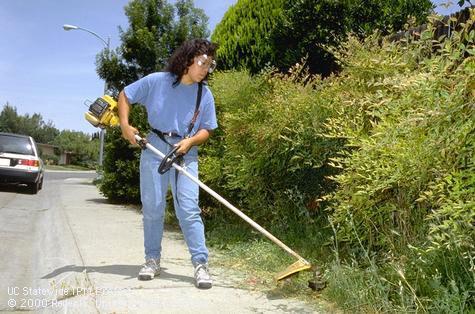

Using a portable weed trimmer.
Cultivation (hoeing) and hand weeding selectively remove weeds from ornamental plantings. If weeds are scattered throughout the site, hand weeding may be the preferred management method. Hand weeding can be time consuming, but should be included in all weed management programs to keep weeds from seeding. Hand weeding must be repeated frequently until the plantings become established. Cultivation can damage ornamentals with shallow roots, bring weed seeds to the soil surface, and propagate perennial weeds. When cultivating, avoid deep tilling, as this brings buried weed seeds to the soil surface where they are more likely to germinate.
Perennial weeds are often spread by cultivation and should be controlled or removed by other methods. Frequent removal of weeds when they are small and have not yet set seed will rapidly reduce the number of annual weeds.
Young weeds in open areas also can be controlled with small flaming units. Propane burners are available to rapidly pass over young weeds to kill them. A quick pass over the plant is all that is necessary; do not burn the weed to the ground. Flaming is more effective on broadleaf weeds than grasses. Be careful not to flame dry vegetation, dry wood chips, or near buildings and other flammable materials, and don't get the flame near desired plants.
Mowing can be used to prevent the formation and spread of weed seeds from many broadleaf weeds into cultivated areas by cutting off flower heads. However, weeds that flower lower than the mowing blade (such as spotted spurge or common woodsorrel) are not controlled. Repeated mowing tends to favor the establishment of grasses and low-growing perennial weeds. Mowing of some ground covers can rejuvenate them and make them more competitive against weeds.
The top growth of older weeds can be controlled by using a string trimmer. Annual broadleaf weeds are more effectively controlled than annual grasses because the growing points of grasses are usually below ground. Most perennial weeds are not controlled using string trimmers but trimming will make them less noticeable in areas if you are limited in other methods for control.
Prevent repeated damage to trunks of established woody perennials from the string trimmer by placing a temporary shield around the trunk. Create your own shield by placing a segment of irrigation pipe that is several inches in diameter and split lengthwise around the base of the trunk.
There are several machines currently available that use superheated hot water or steam to kill weeds. The equipment is expensive to purchase and maintain, so these machines are not appropriate for home use. However, commercial landscapers may find them useful in certain situations where the use of herbicides is not desired such as when line-marking playing fields, in playgrounds, around woody plants, for edging, and for weeds growing along fence lines. Some brands of equipment travel slowly (about 2 miles per hour) and are probably not cost-effective for weed control along roadsides. Because these methods employ boiling water or steam, workers must be adequately trained in the use of the machines to prevent severe burns. These machines are most effective on very young annual weeds or perennials that have recently emerged from seeds. The effect is similar to that of a nonselective, postemergent herbicide. Hot water and steam are not very effective on perennial weeds with established storage organs, such as rhizomes and bulbs, nor do they control woody plants. In general, broadleaf weeds are more easily controlled by this method than grasses A home gardener can apply hot water (greater than 200º F) and achieve a limited amount of weed damage. This method is not very effective because the water temperature rapidly drops once it is removed from the heat source.